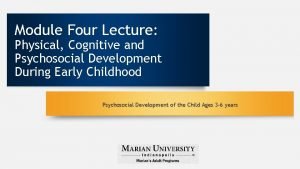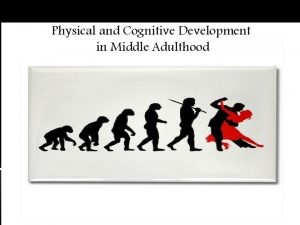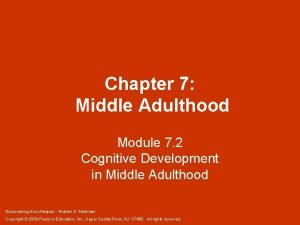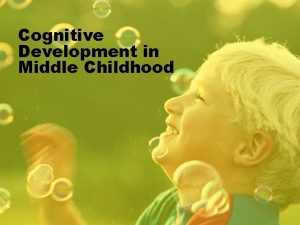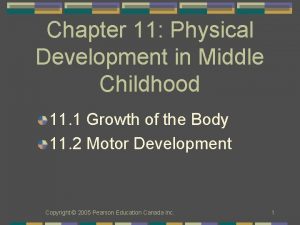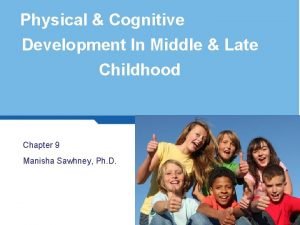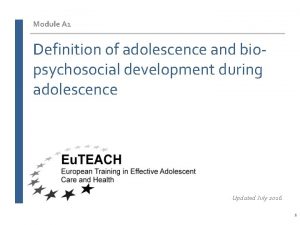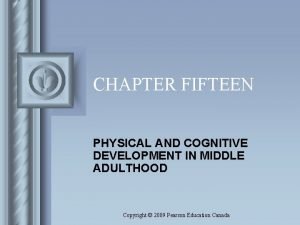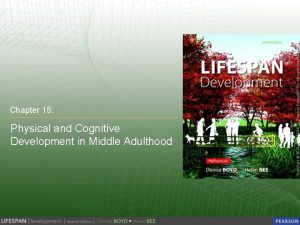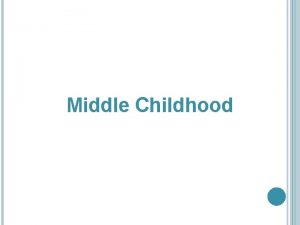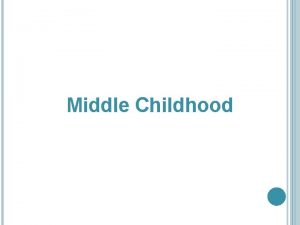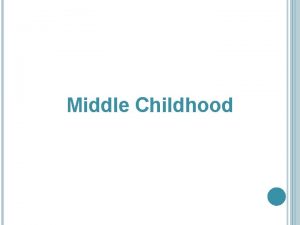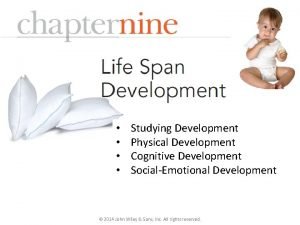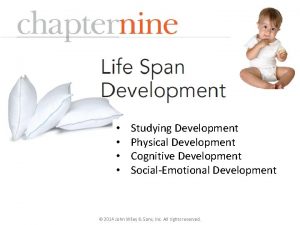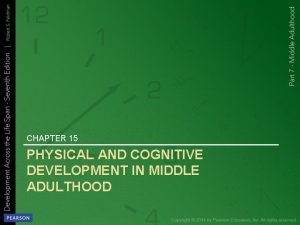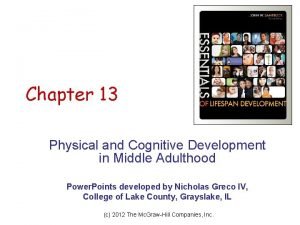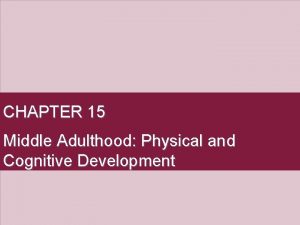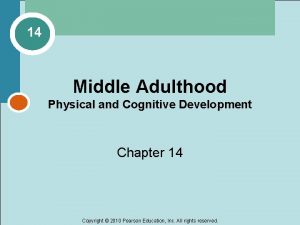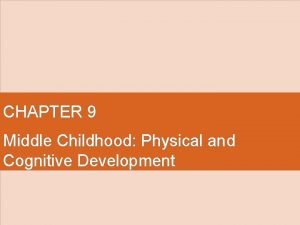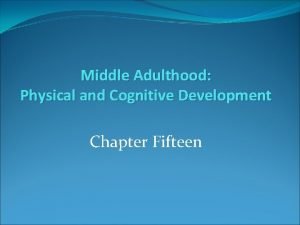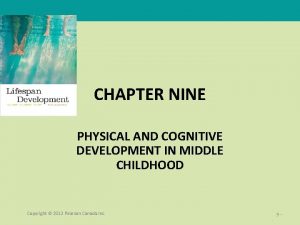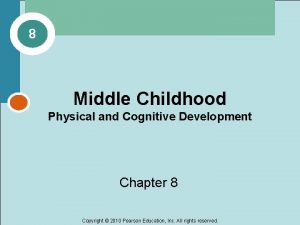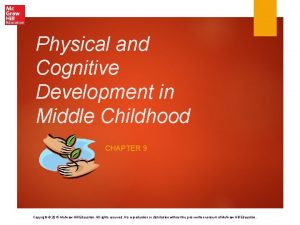Chapter 9 Physical and Cognitive Development in Middle


















- Slides: 18

Chapter 9 Physical and Cognitive Development in Middle Childhood

BODY GROWTH IN MIDDLE CHILDHOOD § § § Slow, regular pattern Girls shorter and lighter until about age 9 Lower portion of body growing fastest Bones lengthen Muscles very flexible All permanent teeth arrive. © Ron Sumners | Dreamstime. com Copyright © 2012 Pearson Education, Inc. All Rights Reserved.

BRAIN DEVELOPMENT IN MIDDLE CHILDHOOD § § © Editors Inc. Weight of the brain increases by 10%, with considerable growth in white and gray matter. Synaptic connections and myelination combine with synaptic pruning, resulting in greater lateralization of cerebral hemispheres. Children acquire complex abilities. Neurotransmitters and hormones may affect cognition and behavior. Copyright © 2012 Pearson Education, Inc. All Rights Reserved.

COMMON HEALTH PROBLEMS IN MIDDLE CHILDHOOD § Overweight and obesity § § § § “Fat letters” (Andover, MA) Vision – myopia Hearing – otitis media Malnutrition Bedwetting Illnesses Injuries © Pavel Losevsky | Dreamstime. com Copyright © 2012 Pearson Education, Inc. All Rights Reserved.

OBESITY RATES ON THE RISE About 32% of U. S. children and adolescents are overweight. A of U. S. children are obese. dramatic rise in overweight and obesity has occurred in many Western nations. Obesity rates are also rapidly increasing in developing nations. In Copyright © 2012 Pearson Education, Inc. All Rights Reserved. 17% China, for example, 20% of children are overweight, and 7% are obese—a nearly fivefold increase over 25 years ago. Cultural beliefs may contribute to the problem (view overweight as prosperity). Copyright © Allyn & Bacon 2011

HEALTH RISKS FOR OBESE CHILDREN More likely to be overweight adults Lifelong health risks high blood pressure, cholesterol respiratory problems diabetes liver, gall bladder disease sleep, digestive disorders cancer early death

OVERWEIGHT ADULTS IN 18 INDUSTRIALIZ ED NATIONS Figure 11. 2 Copyright © Allyn & Bacon 2011

THE OBESITY EPIDEMIC Overweight Over Copyright © 2012 Pearson Education, Inc. All Rights Reserved. rises with age (from 21% of preschoolers to 35% among older students). 70% of children who are overweight or obese will become overweight adults, at risk for lifelong health problems. Type 2 diabetes is rising rapidly among overweight children, sometimes with severe, early complications. Copyright © Allyn & Bacon 2011

CAUSES OF OBESITY IN MIDDLE CHILDHOOD § § § Overweight parents Low SES Parents’ feeding practices overfeeding overly controlling § § § Low physical activity Television Cultural food environment ©Kornilovdream/Dreamstime. com Copyright © 2012 Pearson Education, Inc. All Rights Reserved.

OBESITY TRENDS AMONG AMERICANS, 1990 AND 2008 Copyright © 2012 Pearson Education, Inc. All Rights Reserved. Figure 11. 4 Copyright © Allyn & Bacon 2011

VISION AND HEARING Myopia (nearsightedness) most common vision problem Affected by heredity, early biological trauma, low birth weight, increased eye strain Increases with SES Otitis media (middle ear infection) common in early childh dec Repeated infections may cause hearing loss. Regular vision and hearing screenings recommended Copyright © 2012 Pearson Education, Inc. All Rights Reserved.

BEDWETTING Nocturnal enuresis (bedwetting) occurs in 10 children. Mostly biological in nature Treatment options include medication or a urine alarm. © Tegotego | Dreamstime. com Copyright © 2012 Pearson Education, Inc. All Rights Reserved.

ILLNESSES IN MIDDLE CHILDHOOD More acute illnesses first two years of school Exposure Still developing immune system Chronic 20% diseases: 5– Asthma Severe illnesses – 2% © Vasyl Dudenko | Dreamstime. com Copyright © 2012 Pearson Education, Inc. All Rights Reserved.

ACCIDENTS IN MIDDLE CHILDHOOD Most common types: Motor vehicle Bicycle Pedestrian Prevention: Teach safety. Model safe behavior. Require helmets. Watch high-risk children closely. more © Krisgun 01 | Dreamstime. com Copyright © 2012 Pearson Education, Inc. All Rights Reserved.

U. S. RATES OF INJURY MORTALITY FROM MIDDLE CHILDHOOD TO ADOLESCENCE Copyright © 2012 Pearson Education, Inc. All Rights Reserved. Figure 11. 5 Copyright © Allyn & Bacon 2011

MOTOR DEVELOPMENT IN MIDDLE CHILDHOOD Gross-Motor Skill Improvements Flexibility Balance Agility Force Fine-Motor Writing Drawing Skill Gains Copyright © 2012 Pearson Education, Inc. All Rights Reserved. © Editors Inc.

PHYSICAL PLAY DEVELOPMENT IN MIDDLE CHILDHOOD § Child-organized games with rules Sports Invented games § § Video games Adult-organized sports Physical education Rough and Tumble Play Copyright © 2012 Pearson Education, Inc. All Rights Reserved. © Tony Dudley | Dreamstime. com

SCHOOL RECESS 7% of U. S. schools no longer provide recess to students. About half have recess only once a day. Recess periods do not subtract time from learning; they actually boost children’s learning capability. Children may be more active at recess than in gym class. Regular, unstructured recess fosters children’s health and competence physically, academically, and socially. Copyright © 2012 Pearson Education, Inc. All Rights Reserved.
 Cognitive development in middle and late childhood
Cognitive development in middle and late childhood Physical development in adulthood
Physical development in adulthood Cognitive development in early adulthood
Cognitive development in early adulthood Define physical cognitive and psychosocial development
Define physical cognitive and psychosocial development Cognitive development for middle adulthood
Cognitive development for middle adulthood Cognitive development middle adulthood
Cognitive development middle adulthood Language development in middle childhood
Language development in middle childhood Physical development in middle childhood chapter 11
Physical development in middle childhood chapter 11 Cognitive and non cognitive religious language
Cognitive and non cognitive religious language Late childhood physical development
Late childhood physical development Chapter 5 cognitive development in infancy and toddlerhood
Chapter 5 cognitive development in infancy and toddlerhood Middle adolescence physical development
Middle adolescence physical development Middle adulthood physical development
Middle adulthood physical development Physical development in middle childhood
Physical development in middle childhood Physical changes in early adulthood
Physical changes in early adulthood Kellogg drawing stages
Kellogg drawing stages Early childhood is ____ for language learning
Early childhood is ____ for language learning Denny's model of physical and cognitive ageing
Denny's model of physical and cognitive ageing Denny's model of physical and cognitive ageing
Denny's model of physical and cognitive ageing



